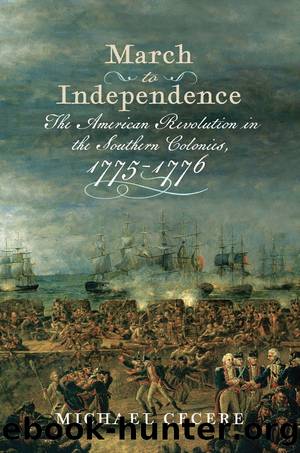March to Independence by Michael Cecere

Author:Michael Cecere [Cecere, Micheal]
Language: eng
Format: epub
ISBN: 9781594166846
Publisher: Westholme
Part II
1776
Five
Winter
AT THE START OF 1776, BOTH GENERAL WASHINGTON AND THE Continental Congress waited anxiously for word on the American efforts in Canada. When it finally arrived in late January, the news was not good. The bold American attempt to capture Quebec had failed and cost a promising officer, General Richard Montgomery. A loose siege of the city continued under Colonel Benedict Arnold, who himself was recovering from a leg wound, but the best chance to seize Quebec from the British had failed, and soon the American army in Canada would be in retreat.
The situation in Massachusetts remained relatively stagnant until the end of winter when Colonel Henry Knox arrived from Fort Ticonderoga with heavy cannon that his detachment had dragged across the Berkshire Mountains to be used in Boston. General Washington placed the cannon upon the heights of Dorchester in early March, and within days the British negotiated an agreement with Washington for them to evacuate the city. General Howe decided to withdraw to Halifax, Nova Scotia, to regroup and await reinforcements coming from across the ocean rather than engage in a bloody assault upon Dorchester Heights.
On the political front, no progress whatsoever had been made toward reconciliation. In fact, British policies hardened against all of the colonies. It was clear by the start of 1776 that the dispute between Great Britain and her colonies was to be settled on the battlefield, not the negotiating table.
VIRGINIA
The situation in Virginia in December had swung dramatically in the Virginiansâ favor thanks to their decisive victory at Great Bridge and Dunmoreâs evacuation of Norfolk. The good news continued two weeks after the battle when Captain James Barron of Hampton scored a small naval victory over one of Dunmoreâs tenders off of Hampton (capturing its crew of seventeen) and also seized two vessels loaded with salt, a commodity that was in desperately short supply in Virginia.1 The Committee of Safety in Williamsburg was so impressed with Captain Barron that it authorized him to fit out three armed vessels.2
Fostering a fledgling navy was not the only thing Virginiaâs leaders in Williamsburg had done to strengthen their military capabilities. In mid-December, the Fourth Virginia Convention, meeting in Williamsburg, expanded the colonyâs infantry forces from two regiments of regulars to nine and increased the length of service for the seven hundred men of each regiment to two years.3 By the spring, all nine of these regiments were taken into continental service.
The convention also issued a stinging reply to Dunmoreâs November proclamation of martial law, asserting that he had assumed powers, âwhich the king himself cannot exercise,â had no real interest in reconciling with the colonies, and was âone of the principal causes of the misfortunes under which we now labour.â4 The convention indicted Dunmore as a ârigid executionerâ of âthat system of tyranny adopted by the ministry and parliamentâ and proclaimed that Dunmore âever zealous in support of tyranny . . . hath broken the bonds of society, and trampled justice under his feet.â5
In addition to
Download
This site does not store any files on its server. We only index and link to content provided by other sites. Please contact the content providers to delete copyright contents if any and email us, we'll remove relevant links or contents immediately.
| Anarchism | Communism & Socialism |
| Conservatism & Liberalism | Democracy |
| Fascism | Libertarianism |
| Nationalism | Radicalism |
| Utopian |
The Secret History by Donna Tartt(18694)
The Social Justice Warrior Handbook by Lisa De Pasquale(12069)
Thirteen Reasons Why by Jay Asher(8716)
This Is How You Lose Her by Junot Diaz(6689)
Weapons of Math Destruction by Cathy O'Neil(6068)
Zero to One by Peter Thiel(5618)
Beartown by Fredrik Backman(5533)
The Myth of the Strong Leader by Archie Brown(5358)
The Fire Next Time by James Baldwin(5185)
How Democracies Die by Steven Levitsky & Daniel Ziblatt(5083)
Promise Me, Dad by Joe Biden(5029)
Stone's Rules by Roger Stone(4981)
100 Deadly Skills by Clint Emerson(4785)
A Higher Loyalty: Truth, Lies, and Leadership by James Comey(4768)
Rise and Kill First by Ronen Bergman(4643)
Secrecy World by Jake Bernstein(4584)
The David Icke Guide to the Global Conspiracy (and how to end it) by David Icke(4539)
The Farm by Tom Rob Smith(4397)
The Doomsday Machine by Daniel Ellsberg(4366)
